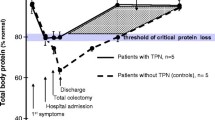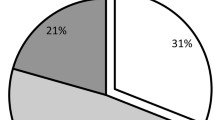Abstract
In critically ill patients accurate measurement of total energy expenditure (TEE) is possible by means of continuous indirect calorimetry. Since in many ICUs the necessary equipment is not available, the Harris-Benedict formula (HB) is frequently used to calculate TEE. Supplemental application of a clinical correction factor (HBc) has been advised. In this study we assessed the reliability of both methods of calculation and of a standard nutritional regimen, all three compared to the calorimetrically measured TEE (gold standard). Although the basic HB-formula did not perform better than the standard regimen, significantly better results were obtained by supplemental application of the clinical correction factor (HBc). It is left undecided, whether or not indirect calorimetry is actually to be preferred in daily clinical practice.
Similar content being viewed by others
References
Abderhalden E, Frank F, Schittenhelm A (1909) Über die Verwertung von tief abgebautem Eiweiß im menschlichen Organismus. Z Physiol Chem 63:215
Apelgren KN, Wilmore DW (1983) Nutritional care of the critically ill patient. Surg Clin North Am 63:497
Askanazi J, Carpentier YA, Elwyn DH, Nordenström J, Jeevanandam M, Rosenbaum SH, Gump FE, Kinney JM (1980) Influence of total parenteral nutrition on fuel utilization in injury and sepsis. Ann Surg 191:40
Askanazi J, Elwyn DH, Silverberg PA, Rosenbaum SH, Kinney JM (1980) Respiratory distress secondary to a high carbohydrate load: a case report. Surgery 87:596
Askanazi J, Carpentier YA, Jeevanandam M, Michelsen CB, Elwyn DH, Kinney JM (1981) Energy expenditure, nitrogen balance, and norepinephrine excretion after injury. Surgery 89:478
Baker JP, Detsky AS, Wesson DE, Wolman SL, Stewart S, Whitewell J, Langer B, Jeejeebhoy KN (1982) Nutritional assessment; a comparison of clinical judgement and objective measurements. N Engl J Med 306:969
Buzby GP, Mullen JL, Matthews DC, Hobbs ChL, Rosato EF (1980) Prognostic nutritional index in gastrointestinal surgery. Am J Surg 139:160
Carlsson M, Nordenström J, Hedenstierna G (1984) Clinical implications of continuous measurement of energy expenditure in mechanically ventilated patients. Clin Nutr 3:103
Danek SJ, Lynch JP, Weg JG, Dantzker DR (1980) The dependency of oxygen uptake on oxygen delivery in the adult respiratory distress syndrome. Am Rev Respir Dis 122:387
Douglas CG (1911) A method for determining the total respiratory exchange in man. J Physiol (Proc) 42:17
Dudrick SJ, Wilmore DW, Vars HM, Rhoads JE (1968) Longterm total parenteral nutrition with growth, development, and positive nitrogen balance. Surgery 64:134
Elwyn DH (1980) Nutritional requirements of adult surgical patients. Crit Care Med 8:9
Elwyn DH, Kinney JM, Jeevanandam M, Gump FE, Broell JR (1979) Influence of increasing carbohydrate intake on glucose kinetics in injured patients. Ann Surg 190:117
Feenstra BWA, Holland WPJ, van Lanschot JJB, Bruining HA (1985) Design and validation of an automatic metabolic monitor. Intensive Care Med 11:95
Feenstra BWA, van Lanschot JJB, Vermey CG, Bruining HA (1986) Artifacts in the assessment of metabolic gas exchange. Intensive Care Med 12:312
Fernandez Mondejar E, Duro Lombardo M, Perez de la Cruz AJ, Merida Morales A, Torres Ruiz JM, Ferron Orihuela JA (1982) Variations in oxygen consumption and carbon dioxide production during parenteral nutrition. Intensive Care Med 8:169
Feurer ID, Crosby LO, Buzby GP, Rosato EF, Mullen JL (1983) Resting energy expenditure in morbid obesity. Ann Surg 197:17
Feurer ID, Crosby LO, Mullen JL (1984) Measured and predicted resting energy expenditure in clinically stable patients. Clin Nutr 3:27
Grant JP (1980) Handbook of total parenteral nutrition. Saunders, Philadelphia London Toronto, p 95
Harris JA, Benedict FG (1919) A biometric study of basal metabolism in man. Publication number 297, Carnegie Institute of Washington, Washington DC
Heatley RV, Williams RHP, Lewis MH (1979) Preoperative intravenous feeding — a controlled trial. Postgrad Med J 55:541
Holter AR, Rosen HM, Fischer JE (1976) The effects of hyperalimentation on major surgery in patients with malignant discase: a prospective study. Acta Chir Scand [Suppl] 466:86
Holter AR, Fischer JE (1977) The effects of perioperative hyperalimentation on complications in patients with carcinoma and weight loss. J Surg Res 23:31
Jeejeebhoy KN (1985) Nutritional support of the critcally ill patient. In: Vincent JL (ed) Update in intensive care and emergency medicine. Springer, Berlin Heidelberg New York Tokyo, pp 152–159
Keys A (1950) The biology of human starvation. University of Minnesota Press, Minneapolis, p 329
Kinney JM (1974) Energy requirements in injury and sepsis. Acta Anaesthesiol Scan [Suppl] 55:15
Kinney JM (1980) The application of indirect calorimetry to clinical studies. In: Kinney JM (ed) Assessment of energy metabolism in health and disease; report on the first Ross Conference on Medical Research. Ross Laboratories, Columbus, Ohio, p 42
Long CL, Crosby F, Geiger JW, Kinney JM (1976) Parenteral nutrition in the septic patient: nitrogen balance, limiting plasma amino acids, and caloric to nitrogen ratios. Am J Clin Nutr 29:380
Long CL, Schaffel N, Geiger JW, Schiller WR, Blakemore WS (1979) Metabolic response to injury and illness: estimation of energy and protein needs from indirect calorimetry and nitrogen balance. JPEN 3:452
Lowry SF, Brennan MF (1979) Abnormal liver function during parenteral nutrition: relation to infusion excess. J Surg Res 26:300
Mann S, Westenskow DR, Houtchens BA (1985) Measured and predicted caloric expenditure in the acutely ill. Crit Care Med 13:173
Mogil RA, DeLaurentis D, Rosemond GP (1967) The infraclavicular venipuncture. Arch Surg 95:320
Mullen JL (1981) Consequences of malnutrition in the surgical patient. Surg Clin North Am 61:465
Müller JM, Brenner U, Dienst C, Picklmaier H (1982) Preoperative parenteral feeding in patients with gastro-intestinal carcinoma. Lancet 1:68
Paauw JD, McCamish MA, Dean RE, Ouellette TR (1984) Assessment of caloric needs in stressed patients. J Am Coll Nutr 3:51
Quebbeman EJ, Ausman RK, Schneider ThC (1982) A reevaluation of energy expenditure during parenteral nutrition. Ann Surg 195:282
Quebbeman EJ, Ausman RK (1982) Estimating energy requirements in patients receiving parenteral nutrition. Arch Surg 117:1281
Rhodes JM, Carroll A, Dawson J, Hall S, Pincock A, Temple J, Elias E (1985) A controlled trial of fixed versus tailored calorie intake in patients receiving intravenous feeding after abdominal surgery. Clin Nutr 4:169
Roulet M, Detsky AS, Marliss EB, Todd ThRJ, Mahon WA, Anderson GH, Stewart S, Jeejeebhoy KN (1983) A controlled trial on the effect of pareneteral nutritional support on patients with respiratory failure and sepsis. Clin Nutr 2:97
Rutten P, Blackburn GL, Flatt JP, Hallowell E, Cochran D (1975) Determination of optimal hyperalimentation infusion rate. J Surg Res 18:477
Schwartz MK, Medwid A, Roberts KE (1955) Fat and nitrogen metabolism in patients with massive small bowel resection. Surg Forum 6:385
Sheldon GF, Petersen SR, Sanders R (1978) Hepatic dysfunction during hyperalimentation. Arch Surg 113:504
Spanier AH, Shizgal HM (1977) Caloric requirements of the critically ill patient receiving intravenous hyperalimentation. Am J Surg 133:99
Thompson BR, Julian ThB, Stremple JF (1981) Perioperative total parenteral nutrition in patients with gastroninstestinal cancer. J Surg Res 30:497
Turner WW, Ireton CS, Hunt JL, Baxter ChR (1985) Predicting energy expenditures in burned patients. J Trauma 25:11
Weir JB de V (1949) New methods for calculating metabolic rate with special reference to protein metabolism. J Physiol (Lond) 109:1
Weissman C, Kemper M, Damask MC et al. (1984) Effect of routine intensive care interactions on metabolic rate. Chest 86:815
Wilmore DW, Dudrick SJ (1968) Growth and development of an infant receiving all nutrients exclusively by vein. J Am Med Assoc 203:140
Young EA (1983) Short bowel syndrome: high-fat versus high-carbohydrate diet. Gastroenterology 84:872
Author information
Authors and Affiliations
Rights and permissions
About this article
Cite this article
van Lanschot, J.J.B., Feenstra, B.W.A., Looijen, R. et al. Total parenteral nutrition in critically ill surgical patients: fixed vs tailored caloric replacement. Intensive Care Med 13, 46–51 (1987). https://doi.org/10.1007/BF00263557
Accepted:
Published:
Issue Date:
DOI: https://doi.org/10.1007/BF00263557




